SLAVERY ISSUE - History of USA #7
- SLAVERY
The practice of enslaving Africans dates back to 15th century. The Portuguese began the practice during the exploration of West African coast. Acquiring slaves from other Africans, the Portuguese took them back to Europe to be employed as servants or laborers.
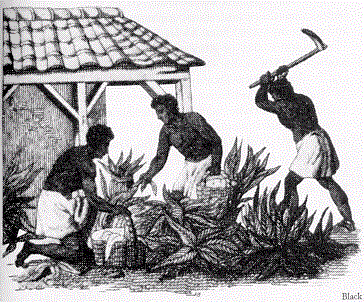
- LABOR IN THE NEW WORLD
Exploration opened up the New World to the European countries in the 16th and 17th centuries. Soon colonies were being abolished. Economic interest in trade created a demand for cheap labor. New World colonists tried various solutions to labor shortage. Efforts to enslave Native Americans failed. They lacked immunity to European diseases. Their ability to organize and rebel against slavery made such efforts impractical. When England's lower class experienced food and word shortages, many immigrated to the new colonies as indentured servants. They agreed to work for seven years to pay the price of their passage. This system worked for a time, though it had many problems, including that of runaway servants. When the English economy improved at the end of the 17th century, fewer people were willing to agree to the arrangement.
- SLAVERY IN AMERICA'S HISTORY
Though the imprisonment of another human being for forced labor is unimaginable today, the institution of slavery has a long history in this country. Slaves were used for labor in the original thirteen colonies.
- AFRICAN SLAVERY IN AMERICA
The first African laborer arrived in the American colonies as early as 1619. Historians are uncertain of the social status of these men. Unlike runaway indentured Europeans who passed themselves off as free as free, Africans were easily identifiable in the New World. Between 1510 to 1870, millions of Africans were captured from their homeland and taken around the world and sold into the life of slavery. Bolstered by the racist notion that the White race was superior to Africans, legislation and court decisions between 1620 and 1670 made African slavery legal in all of the colonies. By 1700, African slaves were approximately 10 percent of the population throughout British North America.
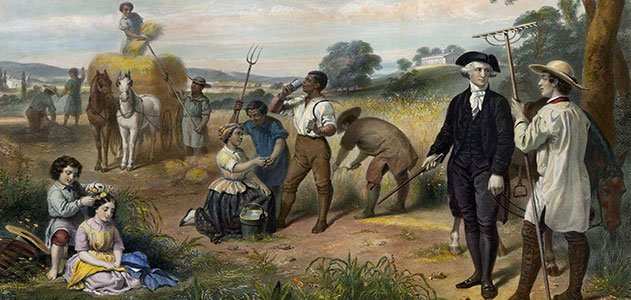
Nearly half of them were brought to the Western Hemisphere where the climate encouraged the large-scale agriculture. The expansion of colonial agriculture during the 18th century intensified the demand for labor. Tobacco, coffee, sugar and rice were the colonies' chief export, and all required a strong and dependable workforce. At the end of the 18th century the farming economy of the south was in trouble. Many wished to convert their farms to grow cotton because England having recently developed new machines to process cotton into cloth, would buy as much cotton as southerners could grow. In 1793 Eli Whitney invented the cotton gin that could process fifty times the amount of cotton that a laborer could process in a day. US Cotton exports skyrocketed from about 3000 bales in 1790 to 178,000 bales in 1810. For southern slaves, Whitney's invention was a disaster. The new cotton economy of the South depended on a huge slave labor force and its production continued to rise until it represented 57 percent of all US exports in 1860. Despite the ban on foreign slave trade, slavery grew and an estimate says that at least three hundred thousand African slaves were smuggled into the country. Some of the US' most revered figures, including George Washington and Thomas Jefferson, were slave owners.
- SLAVERY IN THE ANTEBELLUM SOUTH
The years from 1831 to 1861, the high point of cotton plantation culture, came to be known as the classic era of the Old South. In fact the vast majority of the southerners at the time were struggling farmers who didn't own any slaves. Though few in numbers, the large plantations and their farming operations worked more than twenty slaves and often many more and were a major fact of life in the Antebellum South. These large plantations were the big business of antebellum south. Plantations were self sustained communities with slave quarters, storehouses, smokehouses, barns, tools, livestock, gardens, orchards and fields. Slave laborers usually worked in gangs. Skilled slaves worked as handymen, carpenters, blacksmiths, millers, gardeners and domestics.
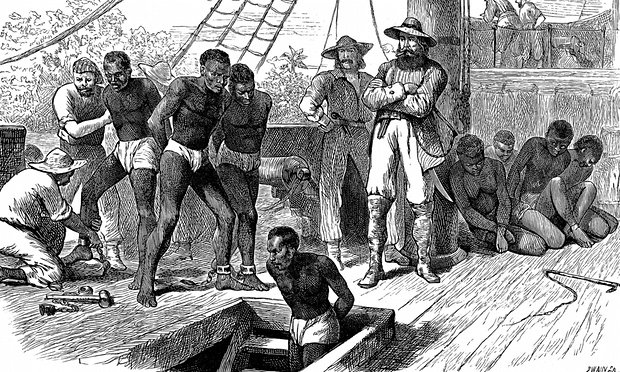
- SLAVE CULTURE
By the 19th century, most slaves had been born in the US and had few direct ties to African countries from where their ancestors were kidnapped. Slave culture was thus shaped within the American plantation system, but African influences were apparent in virtually every aspect of antebellum slave culture, including religion, music, folktales, and social institutions. Even working fifteen hours a day, slaves still found opportunities, for example they talked, sang and courted among their friends. African American culture grew specially in those areas of life where masters rarely intruded.
Many slaves practiced Christianity but they also retained remnants of the African religions of their ancestors. Though it was illegal for black preachers to conduct religious services for black people without a white minister present, slaves held their own religious meetings in secret. They prayed together in a blend of African traditions and Christian concepts. Many slaves found comfort in the Christian idea that their rewards for a hard life would come in the afterlife. Still Southern Whites correctly feared African American slave religion because it encouraged slaves to think about their human condition and measure the injustices they faced. Some of the biggest slave rebellions were planned by black preachers.
- SLAVE CODES & SLAVE PATROLS
Southerners lived in great fear of slave uprisings and did everything in their power to prevent their slaves from finding opportunity to discuss plans for escape or revolt. The Southern states passed "slave codes," which made it illegal for slaves to read or write, to attend church services without the presence of white person. They were forbidden to leave their plantation without a written pass from their masters.
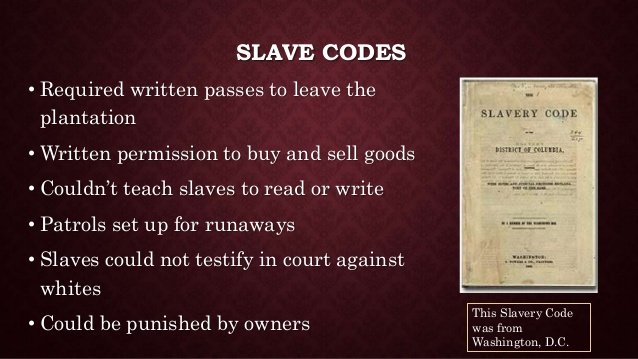
Between 1810 and 1860 all southern states passed laws severely restricting the right of slave owners to free their slaves, even in a will. As a consequence, most southern states required that any slaves who were freed by their masters leave the state within thirty days. To enforce the "Slave Codes" authorities established "slave patrols." These were usually locally organized bands of young white men who rode about at night checking that slaves were securely in their quarters.
- SLAVES DEPRIVED OF BASIC HUMAN RIGHTS TILL 1860
Nevertheless the southern plantation economy could prosper only because of the transfer of surplus slaves from the Upper South to the plantations of cotton-growing Deep South and Old Southwest. Two million slaves were transferred from one region to the other between 1790 to 1860. While many plantations were run by impersonal overseers who did not hesitate to apply the lash, some wealthy southern plantation owners viewed themselves as father figures for their slaves and took pride in treating them with kindness. People who owned smaller farms and worked alongside the slaves tended to be less brutal. Even in these circumstances, though, slaves were treated as inferior beings and denied the ability to chose their own path in life. Most plantation owners kept a strict eye on profits.
This meant that slaves received a bare minimum of the necessities of life. Food was rationed. Shoes were only provided for winter months. Slaves lived in tiny cabins with no doors or windows and very little furniture. To save space and costs, slave owners often crammed as many slaves into a cabin as possible. Sleep was kept to a minimum; work was kept at a maximum. Slaves struggled to keep stable family relations in very difficult situations. Members of a slave family could be sold to a faraway owner and never seen again. Slave owners often raped slave women and in such cases, a woman's offspring might not be the offspring of her husband. Still most slaves placed a high value on marriage. Family and community ties were very strong under the extraordinary circumstances. Resistance and escape in most southern states, whites outnumbered slaves.
- A NATIONAL DEBATE ON SLAVERY ISSUE
Southern states looked to the federal government to support their policies and to protect their slave "property" throughout all of the states. They also thought to expand slavery into new territories as the country grew westward in the 19th century. Between 1777 and 1786 all of the northern states provided for either immediate or gradual emancipation of slaves. Emancipation in the north was a threat to those in the South. Their agricultural economy benefited from the cheap, controlled labor of slavery. To defend the practice, southern thinkers crafted arguments based on race, economic necessity, history and religion. Pro-slavery arguments asserted that the institution was a "positive good" that benefited both the slave and the master.
Economic and philosophic differences between the North and the South caused passionate debates on these issues. Congress passed compromise legislation and the US Supreme Court decided cases to try to balance the rights of the northern and southern states.
The human rights of the slaves got no protection in this national political dance. In one of its most famous decisions, the Supreme Court decided that the slave was a property and not a citizen. Southern slavers celebrated the result. Abolitionists condemned it. Drawing language from the Declaration of Independence, the abolitionists argued that slavery could not exist in a truly free society founded on the natural rights of life, liberty and the pursuit of happiness.
- CRITICAL ANALYSIS
One of the most significant institutions in the history of the United States was slavery. Slavery helped build America. It is a major reason why America developed differently from Europe. It is also a major cause of the disparities that now exist among Americans (much greater than in Europe), and the roots of major social problems are rooted in slavery. It was a principle issue leading to the American Civil War. At this time of war, most slaves took every opportunity to aid the Union army (the army from the North) against the South. During the war approximately five hundred thousand slaves escaped and found haven within the Union lines.
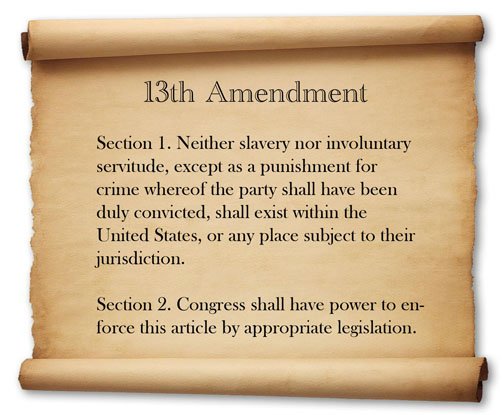
Thirteenth Amendment in US Constitution abolishing slavery from the entire United States
After the Union prevailed in the war, slavery was made illegal throughout the United States with the adoption of the 13th Amendment to the United States Constitution.
In my next article of this series (History of USA), I will discuss the AMERICAN CIVIL WAR and its aftermaths in detail. Stay tuned for more stuff and FOLLOW me @hmjunaid.
Do UP VOTE this post as well!
Thanks!
Congratulations! This post has been upvoted from the communal account, @minnowsupport, by Junaid from the Minnow Support Project. It's a witness project run by aggroed, ausbitbank, teamsteem, theprophet0, someguy123, neoxian, followbtcnews/crimsonclad, and netuoso. The goal is to help Steemit grow by supporting Minnows and creating a social network. Please find us in the Peace, Abundance, and Liberty Network (PALnet) Discord Channel. It's a completely public and open space to all members of the Steemit community who voluntarily choose to be there.
This post has received a 1.56 % upvote from @drotto thanks to: @banjo.